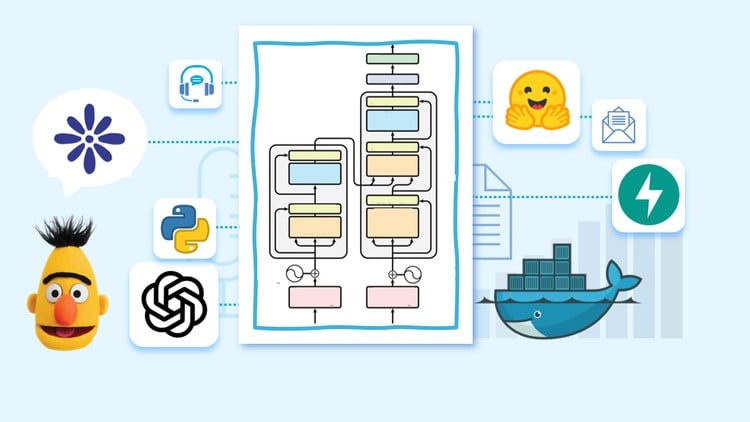Mastering AI With Transformers and LLMs for NLP Applications isn’t just a course; it’s a transformative experience that arms learners with the expertise, practical skills, and innovation-driven mindset needed to navigate and lead in the ever-evolving landscape of Artificial Intelligence.
Why Take This Course?
- Hands-on, project-based learning with real-world applications
- Step-by-step guidance on training, fine-tuning, and deploying models
- Covers both theory and practical implementation
- Learn from industry professionals with deep AI expertise
- Gain the skills to build and deploy custom AI solutions
- Understand challenges and solutions in large-scale AI deployment
- Enhance problem-solving skills through real-world AI case studies
What You’ll Learn:
Section 1: Introduction ( Understanding Transformers) :
- Explore Transformer’s Pipeline Module:
- Understand the step-by-step process of how data flows through a Transformer model, gaining insights into the model’s internal workings.
- High-Level Understanding of Transformers Architecture:
- Grasp the overarching architecture of Transformers, including the key components that define their structure and functionality.
- What are Language Models:
- Gain an understanding of language models, their significance in natural language processing, and their role in the broader field of artificial intelligence.
Section 2: Transformers Architecture
- Input Embedding:
- Learn the essential concept of transforming input data into a format suitable for processing within the Transformer model.
- Positional Encoding:
- Explore the method of adding positional information to input embeddings, a crucial step for the model to understand the sequential nature of data.
- The Encoder and The Decoder:
- Dive into the core components of the Transformer architecture, understanding the roles and functionalities of both the encoder and decoder.
- Autoencoding LM – BERT, Autoregressive LM – GPT, Sequence2Sequence LM – T5:
- Explore different types of language models, including their characteristics and use cases.
- Tokenization:
- Understand the process of breaking down text into tokens, a foundational step in natural language processing.
Section 3: Text Classification
- Fine-tuning BERT for Multi-Class Classification:
- Gain hands-on experience in adapting pre-trained models like BERT for multi-class classification tasks.
- Fine-tuning BERT for Sentiment Analysis:
- Learn how to fine-tune BERT specifically for sentiment analysis, a common and valuable application in NLP.
- Fine-tuning BERT for Sentence-Pairs:
- Understand the process of fine-tuning BERT for tasks involving pairs of sentences.
Section 4: Question Answering
- QA Intuition:
- Develop an intuitive understanding of question-answering tasks and their applications.
- Build a QA System Based Amazon Reviews
- Implement Retriever Reader Approach
- Fine-tuning transformers for question answering systems
- Table QA
Section 5: Text Generation
- Greedy Search Decoding, Beam Search Decoding, Sampling Methods:
- Explore different decoding methods for generating text using Transformer models.
- Train Your Own GPT:
- Acquire the skills to train your own Generative Pre-trained Transformer model for creative text generation.
Section 6: Text Summarization
- Introduction to GPT2, T5, BART, PEGASUS:
- Understand the characteristics and applications of different text summarization models.
- Evaluation Metrics – Bleu Score, ROUGE:
- Learn the metrics used to evaluate the effectiveness of text summarization, including Bleu Score and ROUGE.
- Fine-Tuning PEGASUS for Dialogue Summarization:
- Gain hands-on experience in fine-tuning PEGASUS specifically for dialogue summarization.
Section 7: Build Your Own Transformer From Scratch
- Build Custom Tokenizer:
- Construct a custom tokenizer, an essential component for processing input data in your own Transformer.
- Getting Your Data Ready:
- Understand the importance of data preparation and how to format your dataset for training a custom Transformer.
- Implement Positional Embedding, Implement Transformer Architecture:
- Gain practical skills in implementing positional embedding and constructing the entire Transformer architecture from scratch.
Section 8: Deploy the Transformers Model in the Production Environment
- Model Optimization with Knowledge Distillation and Quantization:
- Explore techniques for optimizing Transformer models, including knowledge distillation and quantization.
- Model Optimization with ONNX and the ONNX Runtime:
- Learn how to optimize models using the ONNX format and runtime.
- Serving Transformers with Fast API, Dockerizing Your Transformers APIs:
- Acquire the skills to deploy and serve Transformer models in production environments using Fast API and Docker.
Becoming a Transformer Maestro:
By the end of the course:
-
- Learners will possess an intimate understanding of how Transformers function, making them true Transformer maestros capable of navigating the ever-evolving landscape of AI innovation.
- Learners will be able to translate theoretical knowledge into hands-on skills
- Understand how to fine-tune models for specific needs using your own datasets.
By the end of this course, you will have the expertise to create, train, and deploy AI models, making a significant impact in the field of artificial intelligence.
Free
If the coupon is not opening, disable Adblock, or try another browser.
If you reach this page after the coupon expired then search the latest coupon here
Tags: udemy coupons 100 off, udemy coupons, udemy coupons 2025, udemy online free courses, Udemy Coupons June 2025
#udemycoupons

